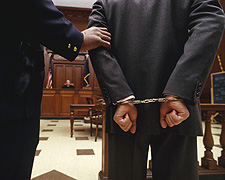A shadow defense is a legal defense that cannot be sustained on its own merits but opens the door to introducing evidence that will assist in seeking jury nullification, and gives the jury an excuse to acquit. [1] A "shadow defense" also may refer to a tactic by defending counsel that is not expected to be successful as a matter of law; it is, instead, a pretext for bringing information into the court that would otherwise be irrelevant and therefore inadmissible.
Jury nullification is a concept where members of a trial jury find a defendant not guilty if they do not support a government's law, do not believe it is constitutional or humane, or do not support a possible punishment for breaking the law. This may happen in both civil and criminal trials. In a criminal trial, a jury nullifies by acquitting a defendant, even though the members of the jury may believe that the defendant did commit the alleged crime. This may occur when members of the jury disagree with the law the defendant has been charged with breaking, or believe that the law should not be applied in that particular case. A jury can similarly convict a defendant on the ground of disagreement with an existing law, even if no law is broken.
In common law jurisdictions, an acquittal certifies that the accused is free from the charge of an offense, as far as the criminal law is concerned. This is so even where the prosecution is simply abandoned by the prosecution. The finality of an acquittal is dependent on the jurisdiction. In some countries, such as the United States, an acquittal operates to bar the retrial of the accused for the same offense, even if new evidence surfaces that further implicates the accused. The effect of an acquittal on criminal proceedings is the same whether it results from a jury verdict, or whether it results from the operation of some other rule that discharges the accused. In other countries, the prosecuting authority may appeal an acquittal similar to how a defendant may appeal a conviction.
An insanity defense might be used to present evidence about a person's troubled childhood, for instance, or a defendant might claim self-defense or duress in order to present evidence about an abusive relationship that nonetheless did not present an imminent mortal danger to the defendant.
The insanity defense, also known as the mental disorder defense, is an affirmative defense by excuse in a criminal case, arguing that the defendant is not responsible for his or her actions due to an episodic or persistent psychiatric disease at the time of the criminal act. This is contrasted with an excuse of provocation, in which defendant is responsible, but the responsibility is lessened due to a temporary mental state. It is also contrasted with a finding that a defendant cannot stand trial in a criminal case because a mental disease prevents them from effectively assisting counsel, from a civil finding in trusts and estates where a will is nullified because it was made when a mental disorder prevented a testator from recognizing the natural objects of their bounty, and from involuntary civil commitment to a mental institution, when anyone is found to be gravely disabled or to be a danger to themselves or to others.

A defendant is a person accused of committing a crime in criminal prosecution or a person against whom some type of civil relief is being sought in a civil case.

Self-defense is a countermeasure that involves defending the health and well-being of oneself from harm. The use of the right of self-defense as a legal justification for the use of force in times of danger is available in many jurisdictions.
An entrapment defense opens the door to presenting evidence about the behavior of police and informants.
In criminal law, entrapment is a practice whereby a law enforcement agent induces a person to commit a criminal offense that the person would have otherwise been unlikely or unwilling to commit. It "is the conception and planning of an offense by an officer, and his procurement of its commission by one who would not have perpetrated it except for the trickery, persuasion or fraud of the officer."
It is reversible error for a trial court to refuse a jury instruction on a theory of defense after a defendant makes a threshold showing as to each element of the defense. [2]
In United States law, a reversible error is an error of sufficient gravity to warrant reversal of a judgment on appeal. It is an error by the trier of law (judge), or the trier of fact, or malfeasance by one of the trying attorneys, which results in an unfair trial. It is to be distinguished from harmless errors which do not rise to a level which brings the validity of the judgment into question and thus do not lead to a reversal upon appeal.